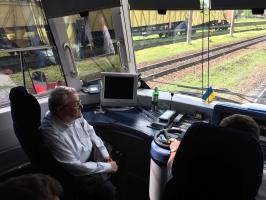Ukraine tunnel reflects boost in EU ties
Beskyd Tunnel was the first of EUR 3bn EU finance for Ukraine
The 130-year-old Beskyd Tunnel leaks. The water that pours through the roof freezes in the bitter winters of the Carpathian Mountains, forming massive icicles that sometimes halt rail traffic out of Ukraine headed for Slovakia and Hungary. But Ukraine’s trade relations with Europe are the opposite of icy. So a new tunnel is under way beside the decrepit old one in this beautiful, remote area 100 km from Lviv—and there will be no ice to hold up the trains.
The 1.8 km tunnel’s two ends connected earlier this year. By early 2018, with its lining and tracks complete, the new tunnel is expected to handle 60% of transit freight from Ukraine to Central Europe. “This transport corridor is of great importance for the Ukrainian economy,” says Mykola Didukh, who heads construction work on the tunnel for Ukrainian Railways, the state rail company. “It makes us closer to Europe in every way.”
The tunnel represents the growing links between Ukraine and the European Union. The two signed an association agreement in March 2014. The expansion of EU involvement in Ukraine includes an increase in lending by the European Investment Bank, which has loaned EUR 2.2 billion to the Eastern European country since 2014. “We are adopting European experience, too,” adds Didukh, “by working with European experts.”
The new Beskyd Tunnel project started more than a decade ago. The aim is to replace the existing tunnel built in 1886 when the region was under the rule of the Austro-Hungarian Empire. Besides the icicles, it’s also a bottleneck because only a single track runs through the tunnel, forcing freight to wait at one end while trains pass in the opposite direction.
It took years for financing and other details to be arranged for the new tunnel. The EIB signed a EUR 55 million loan for the project in May 2014, even as fighting continued elsewhere in Ukraine. The European Bank for Reconstruction and Development also contributed USD 40 million.
“The association agreement made this tunnel supporting trade and mobility even more important for Ukraine and the EU,” says Lionel Rapaille, the EIB division head who oversees public sector deals in Ukraine, as well as elsewhere in Eastern Europe and the Caucasus. “Beskyd was the first deal we did in our major commitment to Ukraine.”
By the end of 2016, the EIB expects its lending to Ukraine since the EU association agreement to reach EUR 3 billion. The EIB has also increased its staff in Kyiv to work on the new projects, which include helping the country to rebuild after the recent conflict and to create infrastructure to cope with 1.7 million displaced people within Ukraine. Other EIB deals are aimed at supporting the modernization of municipal infrastructure, small and medium-sized businesses, agri-businesses, and energy security.
The tunnel meets other EU policy aims beyond closer ties with Ukraine. Much of the freight that will use the new tunnel would otherwise have travelled to nearby Hungary and Slovakia, and then on to Austria by road.
“The economic case for this is that is helps attract more container traffic onto the railway,” says Piers Vickers, the EIB’s deputy economic adviser on strategic railways. “It will promote a modal shift from road to rail. That’s good for the economy and the environment.”
